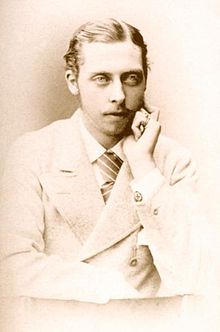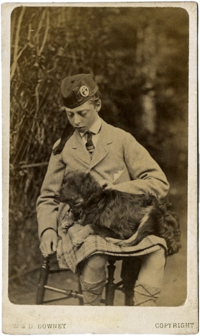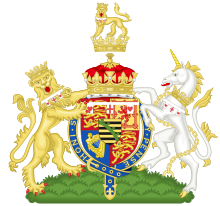Prince Leopold, Duke of Albany
| Prince Leopold | |||||
|---|---|---|---|---|---|
 Prince Leopold, Duke of Albany | |||||
| Duke of Albany | |||||
| Successor | Prince Charles Edward | ||||
| Born | 7 April 1853 Buckingham Palace, London | ||||
| Died | 28 March 1884 (aged 30) Cannes | ||||
| Burial | |||||
| Spouse | Princess Helena of Waldeck and Pyrmont | ||||
| Issue | Princess Alice, Countess of Athlone Charles Edward, Duke of Saxe-Coburg and Gotha | ||||
| |||||
| House | Saxe-Coburg and Gotha | ||||
| Father | Albert, Prince Consort | ||||
| Mother | Queen Victoria | ||||
Prince Leopold, Duke of Albany, KG KT GCSI GCMG GCStJ (Leopold George Duncan Albert; 7 April 1853 – 28 March 1884) was the eighth child and youngest son of Queen Victoria and Prince Albert of Saxe-Coburg and Gotha. Leopold was later created Duke of Albany, Earl of Clarence, and Baron Arklow. He had haemophilia, which led to his death at the age of 30.
Early life

Leopold was born on 7 April 1853 at Buckingham Palace, London. During labour, Queen Victoria chose to use chloroform and thus sanctioned the use of anesthesia in childbirth, recently developed by Professor James Young Simpson. The chloroform was administered by Dr. John Snow.[1] As a son of the British sovereign, the newborn was styled His Royal Highness The Prince Leopold at birth. His parents named him Leopold after his grand-uncle, King Leopold I of Belgium.
He was baptised in the Private Chapel of Buckingham Palace on 28 June 1853 by the Archbishop of Canterbury, John Bird Sumner. His godparents were his first cousin once removed, King George V of Hanover; his fourth cousin once removed, Princess William of Prussia; his first cousin once removed, Princess Mary Adelaide of Cambridge; and his maternal uncle by marriage, Prince Ernst of Hohenlohe-Langenburg.
Leopold inherited the disease haemophilia from his mother, Queen Victoria, and was a delicate child. There was speculation during his life that Leopold also suffered mildly from epilepsy,[2] like his grand-nephew Prince John of the United Kingdom.
Education and career
The Prince's intellectual abilities were evident as a boy; Poet Laureate, Alfred, Lord Tennyson and his friend, philosopher Dr James Martineau, were familiar with the Queen's children and had noted that Leopold, who had often "conversed with the eminent Dr. Martineau, was considered to be a young man of a very thoughtful mind, high aims, and quite remarkable acquirements".[3]
Oxford University
In 1872, Prince Leopold entered Christ Church, Oxford, where he studied a variety of subjects and became president of the Oxford University Chess Club. On coming of age in 1874, he had been made a privy councillor and granted an annuity of £15,000.[4] He left the university with an honorary doctorate in civil law (DCL) in 1876, then travelled in Europe. In 1880, he toured Canada and the United States with his sister, Princess Louise, whose husband John Campbell, Marquess of Lorne, was Governor General of Canada. He was a prominent patron of chess, and the London 1883 chess tournament was held under his patronage.[5] Incapable of pursuing a military career because of his haemophilia and the need to avoid even minor injuries, Leopold instead became a patron of the arts and literature and served as an unofficial secretary to his mother. "Leopold was the favourite son, and through him her relations with the Government of the day were usually kept up."[6] Later he pursued vice-regal appointments in Canada and the Colony of Victoria, but his mother refused to appoint him, to his great unhappiness.
British Army
Despite his inability (through illness) to pursue an active military role, he had an honorary association with the 72nd Regiment, Duke of Albany's Own Highlanders, and from 1881 served as the first Colonel-in-Chief of the Seaforth Highlanders, when that regiment was formed through the merger of the 72nd regiment with the 78th (Highlanders) Regiment of Foot.[7] A portrait of Prince Leopold in military uniform is held in the Royal Collection.[8] The Seaforth Highlanders paraded at Prince Leopold's funeral, a fact recorded by William McGonagall in his poem "The Death of Prince Leopold".[9]
Freemasonry
Prince Leopold was an active Freemason, being initiated in the Apollo University Lodge, Oxford, whilst resident at Christ Church. He was proposed for membership by his brother, Albert Edward, Prince of Wales,[10] who was at the time the Worshipful Master of the Lodge,[11] and was initiated in a joint ceremony with Robert Hawthorne Collins, his friend and tutor, who later became Comptroller of his Household.[12] He served as Master of the Lodge from 1876-1877, and was later the Provincial Grand Master for Oxfordshire, still holding that office at the time of his death.[13]
Duke of Albany
Prince Leopold was created Duke of Albany, Earl of Clarence and Baron Arklow on 24 May 1881.[14][15]
Marriage
Prince Leopold, stifled by the desire of his mother, Queen Victoria, to keep him at home, saw marriage as his only hope of independence. Due to his haemophilia, he had difficulty finding a wife. Heiress Daisy Maynard was one of the women he considered as a possible bride. He was acquainted with Alice Liddell, the daughter of the Vice-Chancellor of Oxford for whom Lewis Carroll wrote Alice's Adventures in Wonderland, and was godfather of Alice's second son, who was named for him. It has been suggested that he considered marrying her, though others suggest that he preferred her sister Edith (for whom he later served as pall-bearer on 30 June 1876).[16]
Leopold also considered his second cousin Princess Frederica of Hanover for a bride; they instead became lifelong friends and confidantes.[17] Other aristocatic women he pursued included Victoria of Baden and Princess Karoline Mathilde of Schleswig-Holstein-Sonderburg-Augustenburg.[17]
After rejection from these women, Victoria stepped in to bar what she saw as unsuitable possibilities. Insisting that the children of British monarchs should marry into other reigning Protestant families, Victoria suggested a meeting with Princess Helene Friederike, the daughter of Georg Viktor, reigning Prince of Waldeck-Pyrmont. On 27 April 1882, Leopold and Helena were married, at St George's Chapel at Windsor Castle, and his income was raised by parliament to £25,000.[4] Leopold and Helena enjoyed a happy (although brief) marriage. In 1883, Leopold became a father when his wife gave birth to a daughter, Alice. He died shortly before the birth of his son, Charles Edward.
Illness and death
Prince Leopold had haemophilia, diagnosed in childhood and in early years had various physicians in permanent attendance, including Arnold Royle[18] and John Wickham Legg. In February 1884, Leopold went to Cannes on doctor's orders: joint pain is a common symptom of haemophilia and the winter climate in the United Kingdom was always difficult for him. His wife, pregnant at the time, stayed at home but urged him to go. On 27 March, at his Cannes residence, the 'Villa Nevada', he slipped and fell, injuring his knee and hitting his head. He died in the early hours of the next morning, apparently from a cerebral haemorrhage. He was buried in the Albert Memorial Chapel at Windsor. The court observed official mourning from 30 March 1884 to 11 May 1884.[19] His posthumous son, Prince Charles Edward, succeeded him as 2nd Duke of Albany upon birth four months later.
Having died six years after his older sister Alice, Leopold was the second of Queen Victoria's children to die. His mother outlived him by seventeen years, by which time she had also outlived a third child, Alfred.[20]
Leopold's passing was lamented by the Scottish "poet and tragedian" William McGonagall in the poem "The Death of Prince Leopold".
In 1900, Leopold's son, Charles Edward, succeeded his uncle Alfred as Duke of Saxe-Coburg and Gotha.
Through Charles Edward, Leopold was the great-grandfather of Carl XVI Gustaf, the current King of Sweden.
The haemophilia gene is carried on the X chromosome, and is normally passed through female descent, as in the past few haemophiliac men survived to beget children. Any daughter of a haemophiliac is a carrier of the gene. Leopold's daughter Alice inherited the haemophilia gene, and passed it to her elder son Rupert.[21]
Titles, styles, honours and arms

Titles
- 7 April 1853 – 24 May 1881: His Royal Highness The Prince Leopold
- 24 May 1881 – 28 March 1884: His Royal Highness Prince Leopold, The Duke of Albany
Honours
- KG: Knight of the Order of the Garter (1869)[22]
- KT: Knight of the Order of the Thistle (1871)
- PC: Member of the Privy Council of the United Kingdom (1874)[23]
- GCSI: Knight Grand Commander of the Order of the Star of India (25 January 1877)[24]
- GCStJ: Bailiff Grand Cross of the Order of the Hospital of St. John of Jerusalem (1880)[25]
- GCMG: Knight Grand Cross of the Order of St Michael and St George (1880)[26]
Arms
In 1856, at the age of three, Prince Leopold was granted a personal coat of arms — the arms of the kingdom, with an inescutcheon of the shield of Saxony (representing his father), and all differenced by a label argent of three points, the first and third bearing hearts gules, and the second a cross gules.[27]
Issue
| Image | Name | Birth | Death | Notes |
|---|---|---|---|---|
 |
Princess Alice of Albany | 25 February 1883 | 3 January 1981 | later HRH Princess Alice, Countess of Athlone (sister-in-law to Queen Mary) |
 |
Prince Charles Edward, Duke of Albany | 19 July 1884 | 6 March 1954 | Born four months after his father's death; known as 'Charlie'; Leopold Charles Edward George Albert; later reigning Duke of Saxe-Coburg-Gotha |
Ancestors
In popular culture
In the 2001 romantic comedy film Kate & Leopold, "Leopold, Duke of Albany," (Hugh Jackman) is a 19th-century British Duke who time travels to 21st-century New York. A loose analog of the historical Leopold, his surname is given as Mountbatten - an anachronism, as this surname was created in 1917 to de-Germanise the name Battenberg during World War I. The fictional Leopold is credited with having invented the elevator, and has a butler named Otis.
The characters may also reference his nephew, Leopold, son of princess Beatrice. His surname being Battenberg. His name was changed to Mountbatten after the war.
Leopold is also frequently mentioned in stories based on Alice in Wonderland, such as The Looking Glass Wars trilogy.
References
- ^ Queen Victoria: From her birth to the death of the Prince Consort by Cecil Woodham-Smith (New York: Alfred A Knopf, 1972) pgs. 333-334
- ^ Nelson, Michael (2001). Queen Victoria and the Discovery of the Riviera. London: I B Tauris and Co Ltd. p. 38.
- ^ Greenwood, Grace. "Queen Victoria, her girlhood and womanhood". Queen Victoria, her girlhood and womanhood - Part 4 (out of 4). First published - 1883, Montreal, Dawson Bros. Retrieved 21 January 2014.
- ^ a b One or more of the preceding sentences incorporates text from a publication now in the public domain: Chisholm, Hugh, ed. (1911). "Albany, Dukes of". Encyclopædia Britannica. Vol. 1 (11th ed.). Cambridge University Press. pp. 488–489.
- ^ Winter, Edward (4 December 2005), "4044. Prince Leopold, Duke of Albany", Chess Notes, retrieved 13 August 2012
{{citation}}: Cite uses generic title (help) - ^ "Topics of the Week". The Week : a Canadian journal of politics, literature, science and arts. 1 (18): 273. 3 April 1884. Retrieved 30 April 2013.
- ^ Colonels-in-Chief listed at this article.
- ^ "Portrait of Prince Leopold Duke of Albany, 72nd Seaforth Highlanders". Royal Collection Trust. Inventory no. 760302.
- ^ Full text of poem available here.
- ^ "Apollo University Lodge No 357, History 1819 - 1969", privately published 1969, page 19.
- ^ "Apollo University Lodge No 357, History 1819 - 1969", privately published 1969, appendix page i.
- ^ "Apollo University Lodge No 357, History 1819 - 1969", privately published 1969, page 20.
- ^ The Oxfordshire Masonic Year Book, 2011-2012, (154th annual edition), privately published 2011, page 54.
- ^ "No. 24977". The London Gazette. 24 May 1881.
- ^ "Yvonne's Royalty: Peerage". Mypage.uniserve.ca. Retrieved 12 August 2011.
- ^ "Nelson Evening Mail, Volume XI, Issue 233, 22 September 1876, P.4, quoting Home News, 1876". Retrieved 5 August 2010.
- ^ a b Zeepvat, Charlotte (1998). Prince Leopold: The Untold Story of Queen Victoria's Youngest Son. Sutton Publishing. ISBN 0-7509-3791-2.
- ^ "LETTERS TO ARNOLD ROYLE, SURGEON IN ORDINARY TO HRH PRINCE LEOPOLD". Sothebys.
- ^ "No. 24411". The London Gazette. 29 March 1884.
- ^ "boys clothing: British royalty Victoria-the children". Histclo.com. Retrieved 12 August 2011.
- ^ Russel, Peter; Hertz, Paul; McMillan, Beverly. Biology: The Dynamic Science. Belmon, CA: Brooks/Cole. p. 265.
- ^ "No. 23502". The London Gazette. 1 June 1869.
- ^ "No. 24142". The London Gazette. 20 October 1874.
- ^ "No. 24411". The London Gazette. 30 January 1877.
- ^ Reference here.
- ^ "No. 24848". The London Gazette. 28 May 1880.
- ^ Francois R. Velde. "Heraldica – British Royalty Cadency". Heraldica.org. Retrieved 12 August 2011.
External links
- Rigg, James McMullen (1893). . In Lee, Sidney (ed.). Dictionary of National Biography. Vol. 33. London: Smith, Elder & Co.
- Use dmy dates from April 2012
- Alumni of Christ Church, Oxford
- Bailiffs Grand Cross of the Order of St John
- Burials at St George's Chapel, Windsor Castle
- Chess patrons
- Dukes of Albany
- British Freemasons
- Haemophilia in European royalty
- House of Saxe-Coburg and Gotha (United Kingdom)
- Knights Grand Commander of the Order of the Star of India
- Knights Grand Cross of the Order of St Michael and St George
- Knights of the Garter
- Knights of the Thistle
- People from Westminster
- Princes of the United Kingdom
- Grand Crosses of the House Order of the Wendish Crown
- 1853 births
- 1884 deaths
- Members of the Privy Council of the United Kingdom

